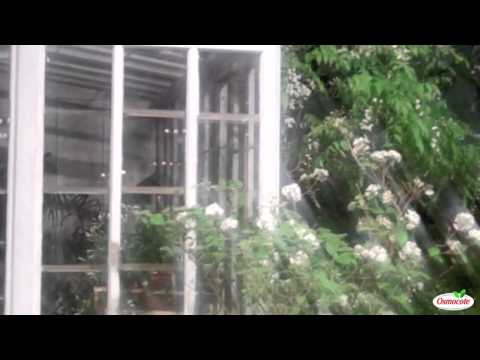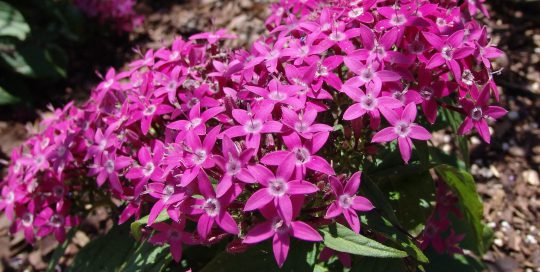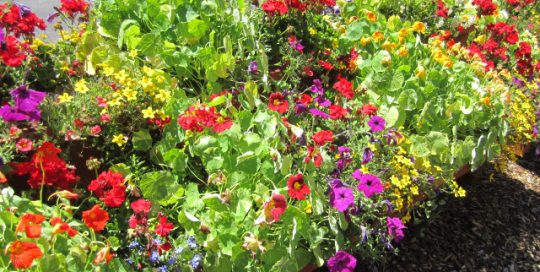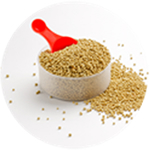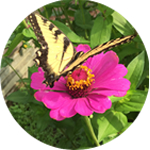What is a cottage garden and why should you grow one? My definition goes like this: a colorful, happy jumble of unrestrained flowers, herbs and vegetables. No empty spaces in the cottage garden. No lawn and no bare soil — the ground is covered with plants that weave their stems, leaves and flowers through those of their neighbors.
When I think of cottage gardens, I picture a spontaneous mix of old-fashioned perennials — sprawling mounds of catmint,lady’s mantle and poppies. There are informal wild sweeps of self-sown annuals.
I see intimate spaces closely connected to the house by flowering shrubs, perennials and vine-covered trellises.
The cottage garden is a marvelous mixture of texture, color and fragrance with flowers for cutting and herbs for cooking. And, it’s the most wonderful excuse to combine everything from peonies and chives to apple trees and roses.
Nasturtiums, lavender, foxgloves,lilies, carnations,peonies, snapdragons,pansies and cornflowersare just a few old-time favorite annuals and perennials that symbolize ‘cottage garden’ style. Many of these fascinating plants, along with sunflowers and alyssum, mingle in my sunny beds and borders, not far from Chicago.
The flowers attract a host of butterflies, native bees, bee-flies, hummingbirds and other nectar-seeking insects. Fragrant viburnum, roses and hydrangeas rub elbows with annuals, perennials and biennials, like hollyhocks.
Parsley, dill and bronze fennel grow in our herb garden, but elsewhere, I sow seeds of these plants to use as fillers between other plants and to attract black swallowtail butterflies.
A bonus — many of these plants offer foliage and flowers that create great bouquets. To brighten my day, I cut stems of cosmos, coneflower, and black-eyed Susans early in the morning and pop them into vases for the kitchen and dining room.
Designing the Cottage Garden
Popular in England for centuries, the cottage garden was a practical, no-nonsense space where medieval cottagers could grow medicinal herbs, vegetables like potatoes and lettuce, and edible flowers. Wealthy Victorians took up cottage garden style during the golden age of horticulture and made it popular.
The English cottage garden is a type of “organized chaos,” consisting of a tight formal structure (boxwood hedge or fence) with a loose, more informal interior. Stone, wood, gravel and recycled brick are often part of the design. Stepping stones, rustic arbors made with tree branches, and other sculptural elements are integral to cottage style.
The garden behind my grandparents’ home in Essex, England, was the epitome of an organized cottage garden. A stepping stone path led to the potting shed. Blue-flowered hydrangeas, roses, climbing vines, a small greenhouse and neat rows of vegetables and herbs flanked the path. Up front, they had a walled garden —no lawn— with an ornamental weeping tree and perennials.
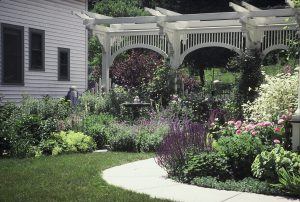
Photo by Nina Koziol
Cottage gardens provide a wonderful opportunity to design a casual and cozy space. It can be an enclosed garden, a walled garden surrounded by small picket fence, a border around a patio or a porch—think intimate sunny spaces.
Although they are often characterized as easy care, spontaneous and low maintenance, cottage gardens can be a lot of work unless you plan carefully. A pleasant illusion is that the garden just happened and it embraces all that is “homey” and humble.
One way to reduce the maintenance is to create a cottage garden feel with your favorite sun-loving plants but plant them in groups, or repeat them through the border so that they get the same care all at once.
12 Popular Cottage Garden Flowers
Here are some of my sun-loving, cottage garden favorites.
-
Cosmos — These bright, colorful annuals can reach anywhere from 10 inches tall to more than four feet. Blossoms may be white, pink, violet or magenta and single or double. The flowers can be used for bouquets, and in late summer, the goldfinches feed the seeds to their young.
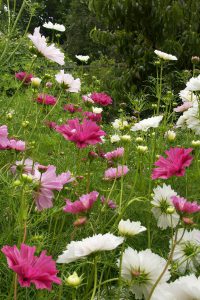 Cosmos – Photo by Nina Koziol
Cosmos – Photo by Nina Koziol - Zinnias — These annuals are the quintessential cottage garden flower in our garden. Breeders have been busy creating new varieties with single and double flowers in a wide range of colors. They are butterfly magnets, especially in late summer when monarch butterflies are migrating.
- Sunflowers — What’s not to like about charming, bright blossoms? Easy to grow from seed, sunflowers come in variety of colors that range from bright buttery yellow to red, red and yellow, deep orange, and creamy white. Flowers can be single, semi-double or, like Teddy Bear sunflower, fully double, 6-inch-wide blooms. Dwarf plants may be as short as 20 inches while mammoth sunflowers can reach 12 feet tall.
- Nasturtium — Easy to grow from seed, nasturtiums offer edible blooms and buds with a peppery or mustard-like flavor. They’re easy to grow from seed—I soak them for two hours before planting.
- Buddleia — Butterfly bush grows throughout our sun-loving flower beds. Its extremely fragrant flowers — purple, violet, white, pink or red-pink — attract hummingbirds and butterflies galore. As soon as the cone-shaped flowers are finished, I remove the seed heads (deadheading) and another flush of bloom takes place.
-
Dahlia — Bold and vibrant, dahlia flowers can be small or the size of a dinner plate. I use the shorter varieties in the front of flower beds with taller varieties in the back of the border. They bloom from June through mid-October and are great in bouquets.
- Salvia — Annuals or perennials, salvia comes in blue, violet, white, pink or red flowers. Salvia ‘Victoria’ stands 16 inches tall and 12 inches wide, and attracts bees and butterflies galore.
- Four O’Clocks — These annuals thrive in full sun and poor, dry soil. The fragrant, trumpet flowers open in late afternoon (thus their name) and they attract hummingbirds and other pollinators. Easy to grow from seed—just direct sow the seeds once there is no danger of spring frost.
- Nepeta — Catmint is a wonderful, long-blooming perennial for the cottage garden. Plant it around shrub roses or with daisies, coneflowers, black-eyed Susan or sunflowers for a long floral show.
- Lavender — A cottage garden favorite that offers fragrance while resisting pests and disease. In the spring, I use hedge clippers to cut off dead stems, leaving the plant about six inches tall. Give lavender a spot in full sun with well-drained soil. Grow it along a sidewalk, patio or path where the reflected heat creates conditions that this plant prefers. One of my favorite combinations is lavender with Pink Delight roses.
- Cleome — This annual is often called spider flower for the masses of spider-shaped white, rose or violet blossoms. Cleome self-sows in our borders where it becomes a pop-up plant among the other flowers.
- Dill — Herbs are an integral part of the cottage garden. I sow seeds of dill, fennel and parsley for use as fillers throughout the sunny areas. They are fragrant and useful in the kitchen and in bouquets, but I mostly grow them because they are magnets for black swallowtail butterflies. The butterflies lay their eggs on the plants, which are host plants for the caterpillars. When dill and fennel flower later in the summer, they are covered with tiny bees.
You Don’t Need a Cottage to Grow a Cottage Garden
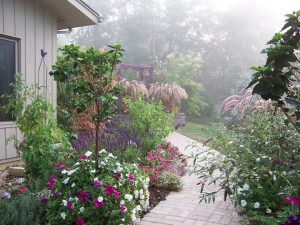
Photo by Nina Koziol
Victorian gardeners treasured scented flowers and you can enjoy them, too, whether you live in a bungalow, ranch house, Tudor or Queen Anne. Dozens of annuals, perennials, bulbs, vines and shrubs offer sweet or spicy scents. The cottage garden is all about exuberance.
Beginning in spring, hyacinths and daffodils fill the air with honey-scented blooms. Viburnums, lilacs, mock orange and lilies-of-the-valley soon follow. Clove-scented carnations, sweet alyssum, sweet peas, roses and lilies continue to perfume the air through summer, and in fall, sweet autumn clematis cloaks fences and arbors with flowers that smell like almond and vanilla. Think abundance.
Learn More about Cottage Gardens
Smithsonian’s Archive of American Gardens
Cottage Gardens in the United Kingdom
America’s Romance with the English Gardenby Thomas Mickey
‘The Well-Designed Mixed Border’, by Tracy DiSabato-Aust


